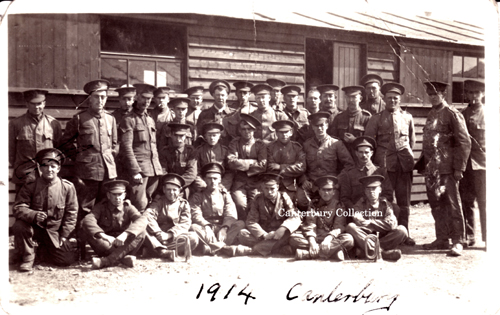In the summer of 1914, the idea of a major war was far from the minds of the populations of both Canterbury and Folkestone. For both these centres, the summer sun had brought along with it the promise of holidaymakers: the former was host to the famous Canterbury Cricket Week in the first week of August, the latter, a destination for peace and tranquillity on the coast for many thousands from home and abroad.
Folkestone, one of the foremost seaside resorts in the country subsequently described by the Reverend J.C. Carlile in his work on Folkestone and the First World War, was ready for its usual visitors:
‘The season was opening; thousands of visitors had flocked to the town, attracted by the health giving breezes from the sea and the charm of the scenery. Passengers crossing from the Continent watch for the white cliffs that stand for England…Little did the happy throng of visitors dream that, just across the Channel, were all the preparations for a great war, that would outrage Belgium and lay waste to the fair fields of France’.
Almost immediately visitors, alarmed as to their safety, swiftly packed their bags and left the town, as The Times reported ‘leaving the townspeople bewailing the fact that their season had been ruined’. The news had ‘cleared the town of Folkestone as effectively as though a plague had desolated her homes’. Within a week though, the Mayor of Folkestone, Sir Stephen Penfold, stated that, except for the inconvenience being felt throughout the country, Folkestone was in a normal state- amusements were as usual, the food supply was ample, and while there were still many visitors in the town, there was room for more in comfort! However, Carlile recalled that, by this stage, bands continued to turn out on the Leas, but no one was there to listen as the boys were enlisting, and women were asking what they could do to help.
A further issue (and to many another inconvenience) lay with the fact that the town had a large number of Germans and Austrians in residence, many working in hotels and guesthouses in the area. Within days many were prepared to answer the call back at home and attempted to leave Folkestone through the Harbour. A small scandal was created by the fact that some were permitted to do so, but this was soon stopped when Folkestone was designated a Prohibited Area. Scuffles even broke out between French and German men trying to board the same ship to Boulogne.
 A fully laden troopship leaving Folkestone Harbour for Boulogne
A fully laden troopship leaving Folkestone Harbour for Boulogne
In Canterbury on 4 August, where the usual preparations had been made for what was the biggest social event of the year, the streets shone with twinkling lights and Japanese lanterns hung on many street corners. Initially, there was no rush to leave as there had been in Folkestone, in fact, large crowds attended the first match at the St Lawrence Cricket Ground, and the Regimental Silver of the East Kent Regiment was on proud display, as it always was during Cricket Week. After the two matches (Kent had lost to Sussex, and then beat Northamptonshire in the second), the usual evening entertainment was available to the many visitors all around the city.
By the third day, however, the crowds had disappeared. Entertainment was difficult to find, in large part due to the fact that many of the bands were made up of military reservists who had been mobilised on the declaration of war. The army took over the Cricket Ground and Canterbury Week came to an unceremonious halt.
Although there appears to have been no initial great enthusiasm at the immediate outbreak of the war, both population centres soon found themselves greatly affected by it. Owing to the fact that Canterbury was home to a large barracks, it was soon inundated with military personnel, many of whom had to be billeted throughout the city. This was to remain the case for the duration of the war as men and women passed through, either on their way to the front, or on their return, many of whom were wounded and treated in the many VAD hospitals in the vicinity.
 A group of soldiers from Canterbury, 1914
A group of soldiers from Canterbury, 1914
For Folkestone, the harsh realities of war were very quickly to present themselves to the population of the town in a variety of ways. Soldiers began to embark ships en-route for France, and many wounded soon began to appear. Most strikingly, within the month, the well-worn faces of thousands of Belgian refugees made their way along the Harbour arm and would become a prominent feature of wartime life in the town for the next four years.